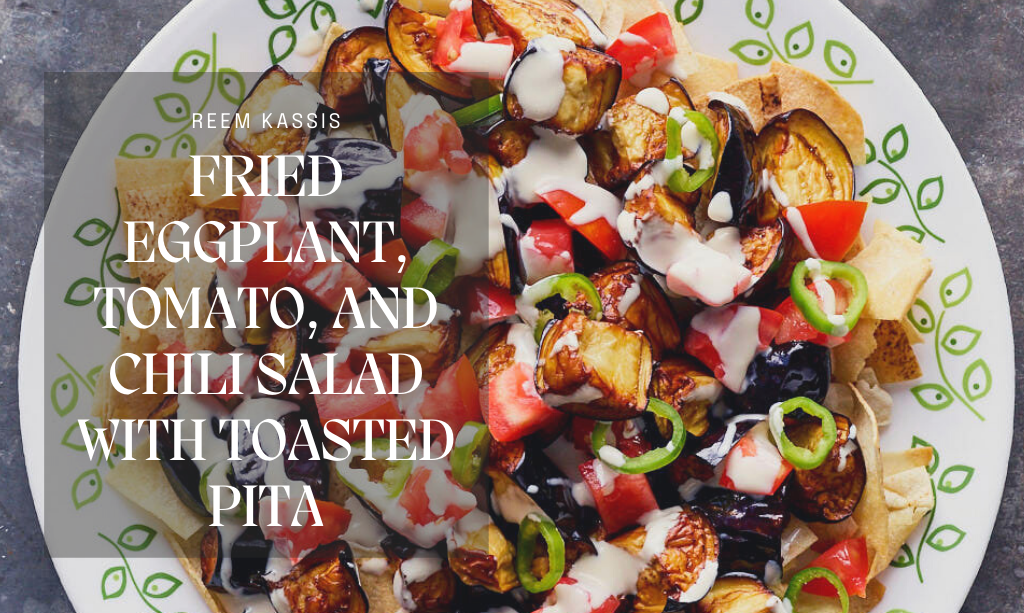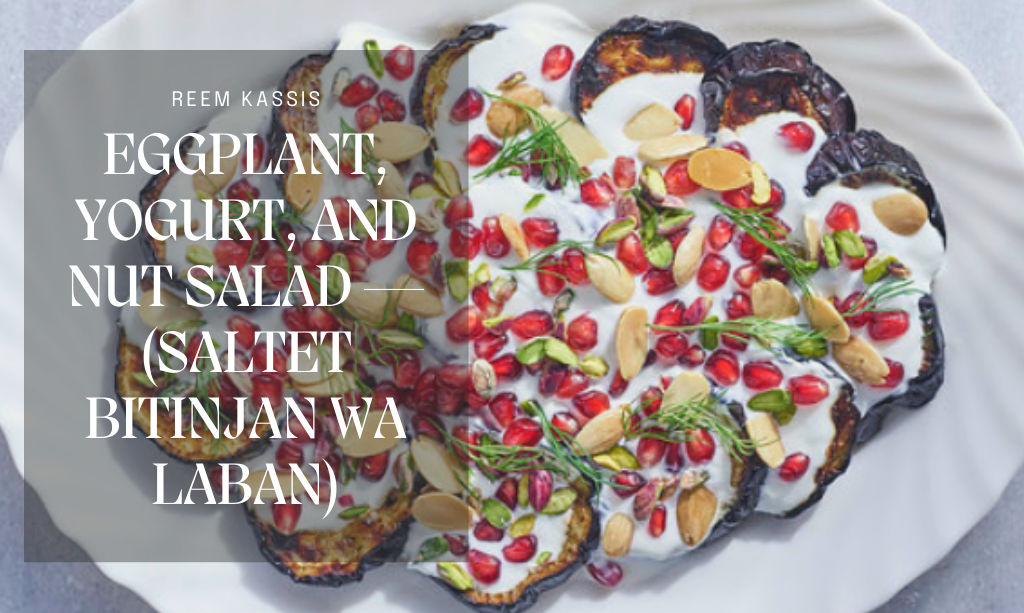It was one of the most magnificent feasts Baghdad had ever seen, and probably would ever see again. It included thousands of pearls scattered on a gold woven mat for guests to help themselves to and a 70-pound candle of ambergris set in a candelabrum made of gold. It was December 825, and Caliph al-Ma’mun was marrying his vizier al-Ḥasan ibn Sahl’s daughter, Khadija, nicknamed Buran. The banquet was lavish and the food extraordinary.
They even made an eggplant dish.
My younger daughter’s eyes widened in anxiety. “They did? What happened?” she asked.
We were eating eggplant maqlubeh for dinner, and I had just finished telling her and her older sister how, once upon a time, people were afraid of the eggplant because they thought it made you mad. The name itself in Arabic, bathinjan, is even thought to be a compound word meaning demon’s eggs.
“It was simple,” I said. “In hindsight we know Buran had salted and rinsed the eggplants, which removed their bitterness, and from that day forward people were less afraid and started eating the eggplant.” At least that was the condensed kid version of the story I recounted over dinner.
My older daughter was not having it; she was more concerned with drama at school. She wanted to know why, if somebody wanted to be your friend, they were still mean to you sometimes. Before I had a chance to formulate a coherent answer, the one parents are somehow always expected to have, her younger sister, a cheeky and opinionated 5-year-old, intervened. “It’s because when you don’t know someone, you’re afraid of them and when you’re afraid you might act mean.” Taken aback by what seemed like an answer too old for her age, I realized where her insight had come from as she finished her sentence.
“Just like the eggplant – people didn’t know it well, and so they said mean things about it.”
Children’s insights are sometimes the deepest of all. It was indeed a lack of knowledge that had relegated the eggplant to the gallows of Arab cuisine. Although eggplant was known to Arabs from at least the time of the Muslim conquest of Iran and spread throughout the Mediterranean Basin as a result of Muslim expansion in the 7th and 8th centuries, it appears it was Buran’s wedding that caused it to surge in popularity. The revelation in the story of Buran’s wedding was that eggplant could be rid of its bitter flavor by sprinkling its cut surfaces with salt. Prior to this, it had always been regarded with fear and disdain. Soon after, the story started to take a brighter turn. Some authors and historians even claim that Buran herself invented the dish served at her wedding and that is why, to this day, many eggplant dishes are referred to as “burraniyat.”
This perennial vegetable, although technically a fruit, probably originated somewhere in South or East Asia (recent studies also point to Africa), where it was cultivated for thousands of years before its journey into the Arab world. Its bitterness might have been valued in Southeast Asia, but this proved less satisfying to palates as it moved westward. The spongy pale flesh also lacked appeal. Perhaps least enticing of all was its color, which led people to call it by the same name as local nightshade, a species commonly recognized as poisonous.
The eggplant had supposedly been described up until the ninth century as having “the color of a scorpion’s abdomen and a taste like its sting.” Physicians viewed it as unhealthy; some even associated it with madness. Ibn Sina believed it caused melancholia, while Abu Bakr Muhammad Zakariyya Razi suggested it could cause pustules in the mouth and inflame the blood.
Following Buran’s wedding, however, the eggplant starts to appear in Arabic poetry, where it is regarded with awe rather than contempt. Ibn al-Rumi referenced it in a poem as a piece of floating amber, and Abu al-Fath (also known as Kushajam) described it as “mesmerizing to the soul,” “a pearl in a black gown with an emerald set,” its “flavor like the exchange of lovers kissing.”
By the 10th century, the Arabic cookbook “Kitab al-Tabikh” reveals an entire section devoted to eggplant recipes, and its use as a substitute in other recipes is documented throughout as well. Many of those dishes are attributed to the Abbasid prince Ibrahim ibn al-Mahdi or to Buran herself. By the 13th century, “Kitab al Wusla ila Al Habib” (Scents and Flavors), a Syrian cookbook, had over 15 recipes for eggplants ranging across various chapters from pickled and sautéed to stuffed and stewed.
By the 14th century, the Ottoman Turks became the predominant power in the region, their cuisine taking its cue from “Kitab al-Tabikh” and another medieval Arabic cookbook, “Kitab Wasf al-At’ima al-Mu’tada.” In the 15th century, the court physician of Sultan Murad II translated the 10th century “Kitab al-Tabikh,” adding more of his own recipes, and the first Turkish cookbook was born. From there, the Ottoman Turks went on to learn and borrow culinary arts from all over the empire, evolving their cuisine into the one of stuffed vegetables, shish kebabs, and baklavas we recognize in the Eastern Mediterranean today. Although the eggplant was readily available and cheap from the 16th century onward, it wasn’t until the 18th century that it became their vegetable par excellence. This privileged status rested on both its flavor and its versatility, with the Turks claiming to know more than 40 ways of preparing it. The dishes range from smoked, roasted, or mashed as a “poor man’s caviar” to casseroles, stuffed, fried, and stewed, even pickled or preserved as a jam.
The popularity of the eggplant was replicated in other parts of the world. Islamic expansion into Europe heavily influenced cuisine and introduced new vegetables across the continent, although the rate of adoption varied widely from one country to the next. Eggplant proved particularly successful and gained wide popularity in Spain by the 13th century. In Italy, it was commonly eaten as a Lenten food by the 15th century, but in France, even by the 18th century, it was only known in the southern parts. It would seem much of the reluctance, or hindrance to its popularity, was due to ancient falsehoods about the eggplant or to a shortage of good recipes.
Today, it is hard to fathom any cuisine we consume in the U.S. without eggplants (from Indian and Chinese to Italian and Arab). But even here, eggplant was not always as popular or readily available as it is now. The prevalence of the eggplant and other Mediterranean staples, like chickpeas and peppers, on supermarket shelves is often credited to the arrival of Italian and Arab immigrants into this country and, later, the rising interest in Middle Eastern cooking. Claudia Roden’s first cookbook, “A Book of Middle Eastern Food,” is often credited with growing interest in our region’s food, and from there, the influx of books on the various national cuisines of the region sustained people’s curiosity.
Still, even with ever-increasing infatuation with Middle Eastern and Mediterranean cuisines, only a certain variety of eggplant is available in most mainstream supermarkets in the West — the globe eggplant. However, there are countless other varieties — from Italian, Asian, and fairytale to white, Indian, green, and Thai — which are mostly to be found in farmers markets or specialist grocery stores.
I remember growing up in Jerusalem, we had eggplant in various ways on a regular basis at home: There was maqlubeh, eggplants stuffed with rice and meat in tomato sauce, eggplants stuffed and cooked with grape leaves, yalanji (vegetarian stuffing), eggplants baked in a tray with lamb, mutabbal with tahini, mutabbal with vegetables, fried eggplant cubes mixed in with a vegetable salad, fried slices layered in a sandwich with tahini, broiled or fried slices layered with labneh and pine nuts, stewed eggplants with tomatoes and onions, pickled eggplants, and even candied. The varieties of eggplants were also numerous, from ajami (non-Arab) and bateeri (from Battir) to franji (foreign) and baladi (local).
These days, my table does not have this vast variety on a regular basis, but eggplant does feature commonly, most often in the form of maqlubeh. Convincing my daughters to eat it is another matter altogether, and that’s where all the stories about the eggplant’s past come into play. It’s indeed fascinating to hear those stories and to learn about the evolution of the eggplant’s valued position in Arab cuisine, especially when you realize it took centuries for it to gain that status. Today, this evolution is happening much faster. As information exchange accelerates, global travel rises, and social and technological advancements occur, the way people think, interact, cook, and eat rapidly changes. We can explore new cultures and countries from the comfort of our homes; the internet gives us access to learn more about and even purchase foreign ingredients and dishes; and an increase in migration means we can experience some of these foreign cuisines right in our backyards.
But if the history of the eggplant has shown us anything, it is that our initial inclination is to fear and shun what we don’t know. But every dish, every ingredient, and every flavor we eschew out of repulsion or fear may actually turn out to be the next eggplant in our own lives. So next time you are in a foreign restaurant or at someone’s house, even if there are no pearls strewn on the floor for you to pick up or a 70-pound golden candelabra lighting the room, go for that dish you normally would shy away from, and maybe, just maybe, you’ll find yourself pleasantly surprised.
RECIPES

Whenever my mother made maqlubeh for us growing up, she would have a platter of fried eggplant off to the side in the kitchen. I would take a few slices, slip them into a pita bread with some tomatoes and green chilis, then drizzle a very sour tahini sauce on top. It was, and remains, one of my favorite sandwiches of all time. As simple as it sounds, the flavors and textures are sublime. This salad is my take on those childhood sandwiches.
Serves 4 (as appetizer or part of a spread)
Ingredients
1 white pita bread, about 2 ounces (55 grams)
For the sauce:
4 tablespoons tahini
2 tablespoons plain yogurt
1 tablespoon fresh lemon juice, plus more to taste
1/4 teaspoon kosher salt, or to taste
For the eggplant:
1 medium eggplant, about 12 ounces (350 grams)
Vegetable oil, for deep frying
Salt
1 small tomato, finely diced
1 small green chili, thinly sliced
Method
Preheat the oven to 350° F (180° C/Gas Mark 4).
Cut the pita bread into 3/4-inch (2 cm) squares and arrange on a baking sheet. Bake, moving the bread around from time to time, until the squares are completely dry and crisp and starting to darken in color, about 15 minutes. Remove and set aside. (This step can be done a couple of days in advance.)
Make the sauce:
In a bowl, stir together the tahini, yogurt, 3 tablespoons water, lemon juice, and salt. Taste and adjust the salt and lemon to your liking. Set aside.
Make the eggplant:
Halve the eggplant lengthwise, then in half lengthwise again, then cut each strip crosswise into cubes.
Pour about 3 inches (7 cm) vegetable oil into a deep fryer or heavy Dutch oven (casserole dish) and heat to 350° F (180° C) or until a morsel of bread immediately rises to the surface when dropped in. Pat the eggplants dry with paper towels. Working in batches, fry the eggplants until golden brown, about 5-8 minutes. Remove with a slotted spoon and drain on paper towels. Sprinkle with salt.
To assemble, scatter the toasted pita in a serving platter. Spread the fried eggplants evenly on top. Drizzle the tahini sauce over the eggplant. Top with the diced tomatoes and chili. Serve immediately.

Whenever we invited people over for a big lunch, my mother would usually make a variation of this salad, and it would be the highlight for me. Her version was much richer than this one because she fried the eggplants, used a very strong garlic labneh instead of yogurt, and topped it with plenty of fried pine nuts. Over the years I’ve adapted it into something that we can eat at home on a weekly basis — just as flavorful but on the lighter and healthier side. As far as the nuts and garnish go, I often play around with it depending on my mood, so feel free to adjust based on what you have at hand.
Serves: 4-6
Ingredients
For the eggplants:
4 medium eggplants, about 2.2 pounds (1 kilogram)Olive oil for brushing
Salt
Pepper
For the yogurt sauce:
1 1/2 cups (400 grams) Greek yogurt
1 small garlic clove, crushed
1/2 teaspoon kosher salt
1/2 teaspoon freshly squeezed lemon juice (optional)
For the garnish:
2 tablespoons pomegranate seeds
1/2 cup lightly toasted mixed nuts such as almonds, pistachios, hazelnuts, etc.
A small handful of green leaves such as arugula or chives
Method
Preheat the oven and set it to broil. Slice the eggplants into 3/4-inch (1 1/2-cm) thick rounds and place on an oven rack. Brush both sides of the eggplants with olive oil and sprinkle with salt and pepper. Place the eggplants in the oven right under the broiler until they develop a golden-brown exterior, about 10 minutes. Turn the eggplants over and repeat until the other side is also golden brown, about 10 minutes.
In the meantime, combine all the ingredients for the yogurt sauce and whisk to a smooth consistency. The lemon juice is optional, but it helps bring all the flavors together, especially if using a mellow yogurt rather than a tangy one.
Once the eggplants are done, arrange in overlapping circles on a round platter. Spoon over the yogurt mixture, then top with pomegranate seeds, toasted nuts, and green leaves.



